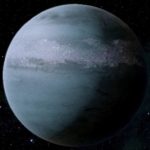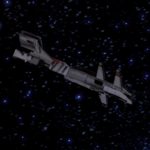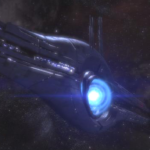System Specs:
- Stellar Mass: 1.00 Sol Masses
- Stellar Class: G
- Luminosity: N/A Sol
- Planets: 4
- Moons: 0
- Asteroid Belts: 0
- Asteroids: 0
- Objects: 2

Prerequisite: Star Chart from Baria Frontiers store or Project Firewalker: Volcano Station (Mass Effect 2)
Prerequisite: Priority: Rannoch (Mass Effect 3)
Hekate is a gateway system. However, geth have been encountered here, so the Systems Alliance put out bulletins declaring all civilian traffic prohibited.
The system’s worlds have moderate to rich resources, even if initial prospects found little by way of precious metals. Bothros, in particular, used to have a spacefaring civilization, and all that’s left of them are archaeological remains and element zero.
Its three terrestrial worlds are all settled, or used to be settled, though living on them comes with some life-support caveats. Humans and asari live on Asteria while batarian criminals build safehouses on Ker. The system appears to have been initially surveyed by the asari; Triodia’s moons are named from their virtues.
–
Planets Directory:
- Asteria
- Ker
- Triodia
- fuel depot
- Bothros
- Mass Relay
–
Asteria:

- Orbital Distance: 1.3 AU
- Orbital Period: 1.5 Earth-years
- Keplerian Ratio: 0.976
- Radius: 5,900 km
- Day Length: 21.4 Earth-hours
- Atmospheric Pressure: 1.2 atm
- Surface Temp: 25 °C (habitable zone)
- Surface Gravity: 0.8 g
- Mass: 0.679 Earth-masses
- Colony: Asari
Capital: Blackdamp, founded 2044 CE, population 188,000,000
A habitable planet known for its arid sulfurous deserts, Asteria is colonized near the poles to avoid the uncomfortable temperatures that can reach 65 degrees Celsius in more southern latitudes. While the seas contain primitive animal life, little of it can live on land, leaving the soil to hardy plants that can survive in the extreme heat. Asteria is home to thriving human and asari agrarian colonies but little in the way of manufacturing or mining.
TRAVEL ADVISORY: Carbon dioxide concentrations can reach 2,500 parts per million in Asteria’s atmosphere. Citizens should carry supplemental oxygen for children and the elderly. Consult with local governments to discuss animal companion detection systems or other preparatory measures.
ALLIANCE BULLETIN: Geth have been encountered in the Hekate system. All civilian traffic is prohibited.
–
Ker:

- Orbital Distance: 2.2 AU
- Orbital Period: 3.3 Earth-years
- Keplerian Ratio: 0.978
- Radius: 6,420 km
- Day Length: 61.7 Earth-hours
- Atmospheric Pressure: 1.2 atm
- Surface Temp: −4 °C
- Surface Gravity: 1.1 g
- Mass: 1.106 Earth-masses
A dry, desolate planet, Ker is temperate but supports little life above the microscopic level. Its Earth-like temperatures and gravity make it an appealing place to build habitation hideaways, attracting batarian slavers and criminals who can’t afford more luxurious safehouses on other planets. Its forgiving nitrogen-helium atmosphere makes EVAs possible with a minimal amount of equipment; a breathing mask and warm clothing is [sic] usually sufficient.
Mining and other legitimate activities are few and far between on Ker: the planet’s crust is largely free of precious metals, instead producing kilometers upon kilometers of dolomitic limestone, calcite, and gypsum.
ALLIANCE BULLETIN: Geth have been encountered in the Hekate system. All civilian traffic is prohibited.
–
Triodia:

- Orbital Distance: 4.8 AU
- Orbital Period: 10.5 Earth-years
- Keplerian Ratio: 1.003
- Radius: 27,206 km
- Day Length: 18.7 Earth-hours
- Atmospheric Pressure: N/A atm
- Surface Temp: N/A °C
- Surface Gravity: N/A g
- Mass: N/A Earth-masses
- Satellites: 14
A modestly-sized gas giant with an icy core, Triodia’s hydrogen and methane atmosphere gives it a bluish color. It has fourteen moons, named after asari virtues.
ALLIANCE BULLETIN: Geth have been encountered in the Hekate system. All civilian traffic is prohibited.
–
Bothros:

- Orbital Distance: 8.5 AU
- Orbital Period: 24.8 Earth-years
- Keplerian Ratio: 0.999
- Radius: 7,191 km
- Day Length: 51.0 Earth-hours
- Atmospheric Pressure: Trace atm
- Surface Temp: −142 °C
- Surface Gravity: 1.5 g
- Mass: 1.893 Earth-masses
A rock and ice planet, Bothros is home to a scientific curiosity. Evidence of a primate-like spacefaring civilization was found frozen in its equatorial ice, ranging from melted fragments of metal to preserved remains of the creatures still wearing suits for extra-vehicular activity. Further exploration revealed that their habitation centers were vaporized by orbital bombardments from railgun-like weapons hitting with a force of approximately 120 kilotons of TNT. Only those that fled or happened to be away from the habitats were preserved in the ice, where they died of asphyxiation.
This unknown species did not come from Asteria, but scientific teams are looking for evidence that they visited there. It is difficult to believe they would colonize a frozen rock like Bothros and ignore a lush garden world. Their world of origin is also a mystery.
ALLIANCE BULLETIN: Geth have been encountered in the Hekate system. All civilian traffic is prohibited.
–
–
video







